Martin Manaranche
 Two existing commercial fast supply vessels were converted into USVs for Overlord testing. The Overlord program, developed by the Office of the Secretary of Defense Strategic Capabilities Office (OSD SCO) in partnership with Program Executive Office Unmanned and Small Combatants (PEO USC), are playing a vital role in informing the U.S. Navy’s new classes of USVs.
Two existing commercial fast supply vessels were converted into USVs for Overlord testing. The Overlord program, developed by the Office of the Secretary of Defense Strategic Capabilities Office (OSD SCO) in partnership with Program Executive Office Unmanned and Small Combatants (PEO USC), are playing a vital role in informing the U.S. Navy’s new classes of USVs.
The U.S. Navy’s Naval Sea Systems Command (NAVSEA) announced a milestone for the program: 1 of 2 Ghost Fleet Overlord test vessels completed a total of two 4-day autonomous transits, with 181+ hours of autonomous operations–over 3,200 nautical miles.
1 of 2 Ghost Fleet Overlord test vessels completed a total of two 4-day autonomous transits, with 181+ hours of International Regulations for Preventing Collisions at Sea 1972 (COLREGs)-compliant autonomous operations--over 3,200 nautical miles.#ExpandingTheAdvantage
About Ghost Fleet Overlord program
The program consists in two phases:
Phase I, which concluded in September 2019, converted two existing commercial fast supply vessels into USVs and focused on autonomy system integration; demonstration of navigational autonomy; and hull, mechanical and electrical system reliability upgrades. Both Overlord vessels executed interactions compliant with the Convention on the International Regulations for Preventing Collisions at Sea (COLREGS). Along with reliability of systems tests, more than 600 hours of autonomy testing was successfully completed during Phase I, including several long-range autonomous transits in a complex navigational environment.
 A Ghost Fleet Overlord test vessel takes part in a capstone demonstration during the conclusion of Phase I of the program in September 2019. Two existing commercial fast supply vessels were converted into unmanned surface vessels (USVs) for Overlord testing, which will play a vital role in informing the Navy’s new classes of USVs. U.S. Navy picture.
A Ghost Fleet Overlord test vessel takes part in a capstone demonstration during the conclusion of Phase I of the program in September 2019. Two existing commercial fast supply vessels were converted into unmanned surface vessels (USVs) for Overlord testing, which will play a vital role in informing the Navy’s new classes of USVs. U.S. Navy picture.
Phase II is being conducted using the same ships from Phase I and focuses on the integration of government-furnished command-and-control systems and payloads and involve more complex and challenging naval experimentation. Phase II will complete in Fiscal Year 2021 at which point the Overlord vessels will transition to the U.S. Navy for further experimentation.
The experiences gleaned from both Phase I and II of Overlord are designed to inform and accelerate the U.S. Navy’s Large and Medium USV programs, which are managed by the same team in PEO USC.
The U.S. Navy released a request for proposals (RFP) to industry for the development of the Medium Unmanned Surface Vehicle (MUSV), on July 16, 2019. It issued the RFP for the Large Unmanned Surface Vehicle (LUSV) combat system in May 2020.
About MUSV Medium Size USV Design Concept on display on Atlas North America stand during SNA 2019. Naval News picture.
Medium Size USV Design Concept on display on Atlas North America stand during SNA 2019. Naval News picture.
 Medium Size USV Design Concept on display on Atlas North America stand during SNA 2019. Naval News picture.
Medium Size USV Design Concept on display on Atlas North America stand during SNA 2019. Naval News picture.
The MUSV will be a pier-launched, self-deploying modular, open architecture surface vehicle capable of autonomous navigation and mission execution with deck space for two standard ISO containers (one 40 feet and one 20 feet).
To support US Navy mission requirements, key attributes of MUSV include extended vessel range (4,500 nm or more at 16 knots transit speed), high sustained speed (27+ knots), high endurance (90 days at sea) without manned maintenance and high reliability (service life of 15 years, capable of surviving sea state 5).
About LUSV Atlas North America and The Columbia Group unveiled an LUSV design concept based on the MEKO 100 hull form during SNA 2020.
Atlas North America and The Columbia Group unveiled an LUSV design concept based on the MEKO 100 hull form during SNA 2020.
 Atlas North America and The Columbia Group unveiled an LUSV design concept based on the MEKO 100 hull form during SNA 2020.
Atlas North America and The Columbia Group unveiled an LUSV design concept based on the MEKO 100 hull form during SNA 2020.
The Large Unmanned Surface Vehicle (LUSV) United States Navy project is set to begin construction in 2020. The LUSV will have the capacity for modular payloads such as anti-ship, anti-submarine or anti-air weapons and be designed to be affordable, high-endurance, reconfigurable ships based on existing hull forms. Capable of operating with human operators in the loop (and aboard for port maneuvers), the U.S. Navy envisions the LUSVs operating alongside fleets as scouts and magazine ships.
$209.2 million of funding for the initial two LUSVs, set to begin construction in 2020, was included in the 2020 Defense Appropriations Bill, with plans to buy eight more over the five-year projection known as the Future Years Defense Program.

No comments:
Post a Comment